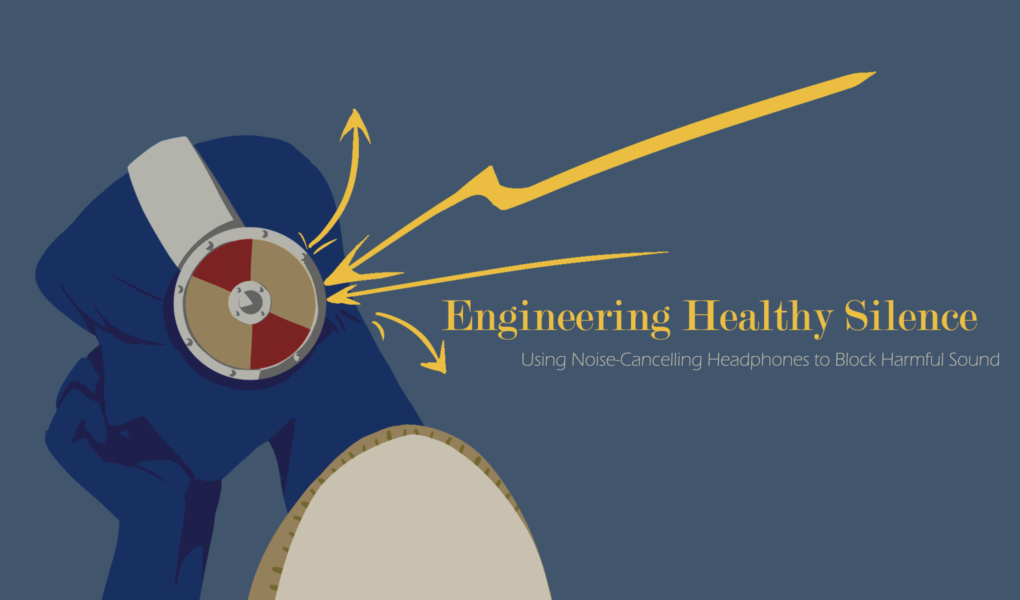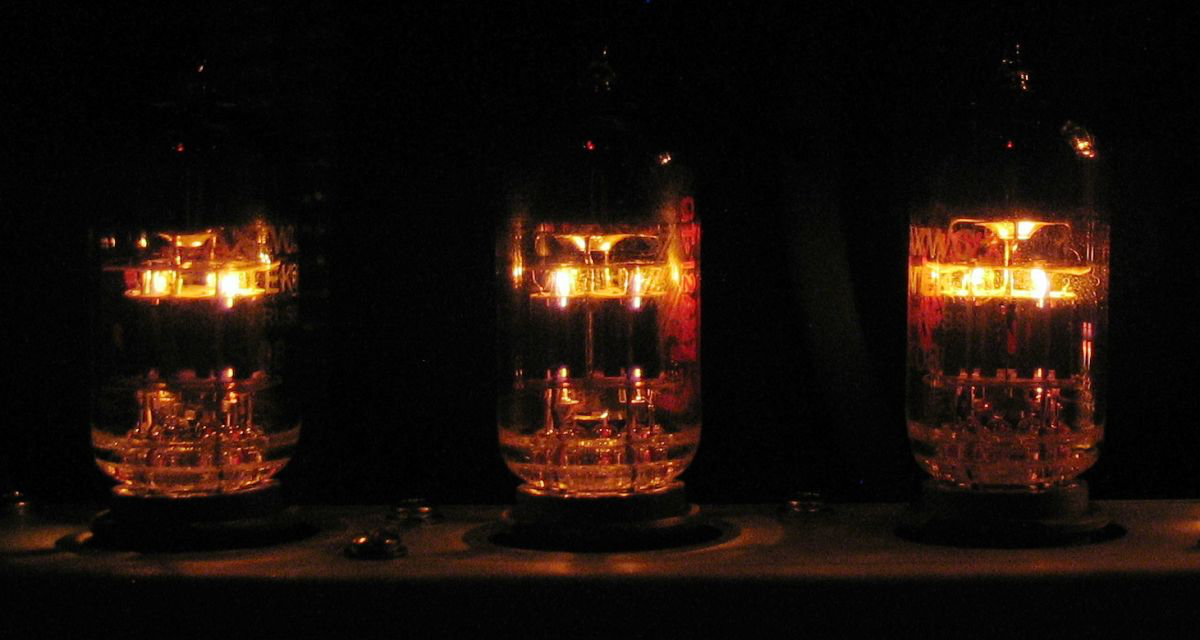Abstract
Long-term exposure to rising environmental noise levels has detrimental health impacts. Active-noise cancellation (ANC), specifically ANC headphones, may provide a solution to alleviate the effects of noise on our lives. ANC employs a principle called superposition to add and effectively cancel two sound waves. ANC technology relies on digital signal processing, which processes audio signals from microphones to generate the correct cancellation wave. While there are limitations to ANC technology, it has potential to become widely applicable in the future with further development.
Keywords
Noise-cancellation, active noise-cancellation, noise-canceling headphones, digital signal processing, ambient noise.
Introduction: Noise is All Around Us
As a college student, walking around campus between classes, studying in the library, and relaxing after a long day all feel incomplete without music from my headphones. In a survey of 280 college students, 84% identified as daily headphone users [1]. Located in a busy city, the constant hum of background noise on campus has made peace and quiet difficult to find. Students wear everything from the newest AirPods to old-school corded earbuds while trying to focus on homework or get pumped up for a gym session. Students do so to combat the steadily rising urban ambient noise in their neighborhoods. [2]. Exposure to this constant stream of disruptive noise [3] from sources like quietly humming appliances, noisy neighbors, or traffic, leaves people susceptible to health problems such as loss of concentration, disruption of sleep, increased annoyance, hearing loss, and cardiovascular diseases [2].
With the health risk of increasing noise levels, engineers developed noise-canceling technology to reduce our perception of noise. This technology has existed throughout history; we often employ passive methods of noise-cancellation like stuffing our fingers in our ears, putting up acoustic padding in theaters, or wearing tight cuffs on our headphones, to absorb sound before it reaches our ears [4]. However, given the increasing levels of urban noise [5], engineers developed another method called active noise cancellation (ANC) capable of further reducing noise [4]. In noisy environments, like a college campus, the widespread use of ANC headphones present a solution to the health risks associated with increasing urban noise. Engineers must strive to improve existing ANC headphones and develop new technology to protect humanity from harmful sounds.
The Nature of Sound: Waves and Superposition
The development of ANC technology is based on the nature of sound and its properties. Sound is a disturbance in the air around us, where the sound continuously pushes and pulls air particles to move like a wave along its path. As shown in Figure 1, the alternating nature of sound waves
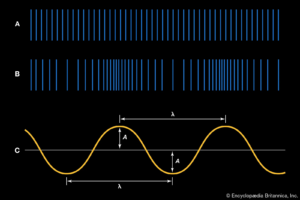
Figure 1: Amplitude A and Wavelength λ of Sinusoidal Wave [6]
gives them a unique pitch and volume. The pitch of a wave depends on frequency or the number of disturbances that pass a set location over time, measured in hertz (Hz). The volume of a sound wave, measured in decibels (dB), depends on amplitude or the height of the peaks [6].
Sound waves are examined in phases, or snapshots of their form at a moment in time. When sound waves traveling through the air interact, the resulting wave is a sum of the two colliding waves [7]. As shown in Figure 2, the waves can be laid on top of each other to examine how they combine. In graph (a) the waves are identical, so when they interact, their amplitudes add up to
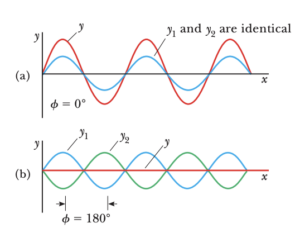
Figure 2: Superposition of Waves [7]
result in a wave with the same frequency but double the volume. In graph (b) the waves are identical in frequency and amplitude, but differ in phase so that their peaks misalign. When the amplitudes are added, the two waves will cancel out and render the sound obsolete [7]. This property of waves is the basis for ANC technology, which ‘hears’ and processes sound waves to generate an anti-noise wave that cancels both sounds [4].
Dangerous Noises: the Frequencies of Different Sounds
Noise from a single source reaches our ears as a uniform sound wave with distinct properties that depend on the original source, its distance from the ear, and any environmental barriers blocking their travel [7]. The effectiveness of ANC technology depends on the sound being cancelled [8], and all sounds are typically measured based on two properties: frequency (in Hz) and volume or amplitude (in dB), which are what our brains use to perceive sound. Their approximate ranges for various close sound sources are shown in Figure 3, along with the range of normal human hearing (white area). Looking at the graph, the normal sound level for conversation lies at 60 dB with a frequency of 100 to 8,000 Hz, while urban traffic has a level of 70 dB with a frequency of 20 to 900 Hz [7]. The brain differentiates sounds when they originate from close sources, but
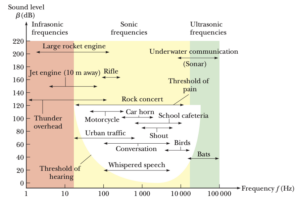
Figure 3: Range of Normal Human Hearing and Everyday Sounds [7]
often cannot distinguish sounds at a distance [9]. These distant sounds combine to create ambient noise, or background sound represented by a single wave, as they travel through other sound waves before reaching the ear. Ambient noise typically has a volume that varies from 60 to 70 dB in urban areas and 45 to 50 dB in suburban neighborhoods [9].
Certain decibel levels are harmful to human hearing and function, especially with repeated exposure to loud noise over large periods of time. In addition to reducing the ability to hear overtime, loud noises have been shown to trigger our “fight or flight” response, the human body’s method of protection against external threats. This response involves an almost instantaneous increase in blood pressure and a later increase in epinephrine and norepinephrine levels, which elevate heart rate and increase energy levels. This shock to the body can disrupt concentration and sleep, while repeated exposure to noise could leave the body with poor cardiovascular health [3]. In 1974, the EPA established 70 dB as the upper level of noise that could be endured daily without any measurable hearing loss, while the World Health Organization finds that the upper limit to prevent loss of concentration is about 45 dB indoors and 55 dB outdoors [2], [3]. With current urban ambient noise levels at up to 70 dB, the average person often exceeds these limits.
Noise-Canceling Headphones: Commercialized ANC to Reduce Noise Impacts
ANC technology has already been applied in many different ways, including in systems like noise-canceling windows to improve sound insulation [4], algorithms that cancel ambulance sirens on the inside, reducing engine noise in vehicles [10], and of course, ANC headphones. The development of ANC technology plays a vital role in reducing the negative health impacts of noise on a large scale. While most applications of ANC solve specific noise-related problems, ANC headphones remain the only commercially available method of protection from dangerous urban noise. Noise-cancelling headphones can block ambient noise from multiple sources, anywhere, anytime. This versatility and accessibility proves invaluable for reducing the harmful impacts of urban noise on a large scale [9], as shown by their rising popularity. This section highlights the development of ANC technology, specifically ANC headphones, describing their current design and its limitations.
- The Development of Active Noise-Cancellation: Digital Signal Processing
To cancel a variety of different ambient sound waves, ANC systems rely on adaptive digital signal processors (DSPs) that translate incoming signals to produce the corresponding anti-noise wave [10]. The current standard ANC system is a hybrid model that uses two microphones, one feedforward and one feedback, to pick up the ambient noise and account for any errors in the processing. Feedforward systems, as seen in Figure 4, contain an external microphone that sends continuous signals to the DSP, which provides an anti-noise signal that plays from the cancellation speaker [11]. This straight-forward system provides more processing time, but also reduces precision as it only processes ambient noise once outside the ear [11].
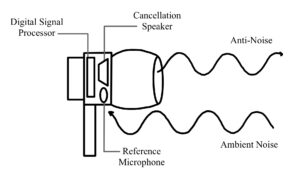
Figure 4: Basic DSP Pathway for Feedforward ANC System
On the other hand, feedback systems receive ambient signals from a reference microphone located in the ear [11], as shown in Figure 5. As time goes on, the microphone also picks up any residual noise from errors in the cancellation, creating a feedback loop that continuously modifies the anti-noise signal depending on the noise in the ear. However, this increased precision takes time, resulting in delays in the cancellation [10]. To combine these methods, the hybrid ANC system uses two microphones located outside and inside of the ear to filter the ambient noise signal [10], [11]. This loop quickly picks up the ambient signal with the outside microphone while listening for errors with the inside microphone, improving precision without sacrificing speed [11].
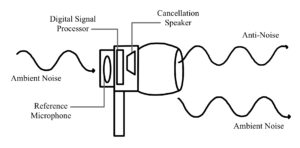
Figure 5: Basic DSP Pathway for Feedback ANC System
Current ANC headphones available commercially all employ the hybrid system. Advancements to the technology have been made to improve cancellation. For example, the popular Apple AirPod Pro earbuds employ an advanced adaptive algorithm that increases the precision of the cancellation while reducing the processing time [12]. Adaptive filters operate based solely on the information received from the microphones by modifying their calculations to produce anti-noise waves dependent upon the incoming signal. This adaptability reduces the error of the anti-noise signal as it passes through the feedforward system, resulting in less delays from the feedback system [13]. To improve the functionality of the system, many ANC headphones contain multiple small microphones located inside and outside the ear. For example, the recently released Apple AirPod Maxes are over-ear ANC headphones with six outward-facing microphones and two inward-facing microphones [14]. Increasing the number of microphones serves to increase the accuracy of the initial anti-noise signal and the subsequent feedforward signal, improving the cancellation. These rapid developments demonstrate the increasing capabilities of ANC technology as a method of safeguarding the public from ambient noise. However, despite these improvements, ANC technology has limitations that prevent total noise-cancellation.
- Limitations of ANC Technology: Adaptability and High Frequency Cancellation
By examining the technology used to process the ambient sound waves, we can see that the biggest limitation for ANC technology is accurately hearing and matching ambient sounds to provide the maximum level of cancellation. For precise cancellation, the phase of the anti-noise wave leaving the speakers needs to line up perfectly with the ambient noise when it reaches the ear. But, the waveform of ambient sound constantly fluctuates, making 100% cancellation impossible to achieve. Despite these limits, the current design of ANC headphones still yields a noise reduction of about 20 to 40 dB, which is a large reduction from ambient levels [15].
While the hybrid model of ANC cancellation accounts for the differences in ambient noise outside and inside the ear, the drawback of this microphone configuration is that it struggles to cancel higher frequency noise. Low frequency waves have longer waveforms that line up easier with their anti-noise signals, while sounds at higher frequencies are more likely to misalign and create feedback [15]. Higher frequency waves are more prone to shifts, which the feedforward ANC microphone struggles to predict and adapt into the anti-noise wave. Additionally, the feedback ANC microphone struggles to correct errors from higher frequency noise, as the waves tend to be more difficult to perceive in the ear. Thus, ANC headphones have a noticeable dip in functionality at 1,000 Hz, making them better suited for reducing sustained sounds with low volume and frequency [16]. However, ANC headphones are equipped with other technology to account for the limitations of their ANC systems.
- Passive Cancellation: Preventing Leakage and Blocking High Frequencies
Many ANC headphones currently on the market are equipped with active and passive noise cancellation, including large ear cuffs that completely enclose the ears or smaller earbuds that seal the inner ear canal [17]. Both methods contribute to cancellation, with the passive noise-cancellation acting as a barrier that seals the ear to prevent leakage [11], [16]. Leakage reduces the cancellation effect of the anti-noise while increasing delay [19], so the fit of the
Figure 6: In-Ear and Over-Ear Noise-Cancelling Headphones [18]
headphones is especially important. Many headphones come with multiple sizes of earbuds or cuffs that prevent leakage by providing the tightest seal possible [11]. These tight seals have another purpose: reducing the high frequency sounds missed by ANC technology. A comparison of ANC headphones against simple passive noise-canceling headphones shows that above 1,000 Hz, passive headphones block just about as much sound as ANC headphones [16]. Therefore, any high frequency reduction within ANC headphones can be attributed to the quality of their passive noise-cancellation. ANC headphones perfectly blend passive and active noise-canceling to provide maximum noise reduction.
Conclusion: Developing a Silent Future
While ANC headphones present a universal, relatively simple method of reducing harmful noise, even the most avid headphone users cannot wear ANC headphones all day, every day. The nature of headphones leaves users vulnerable to the impacts of loud noise during certain times, like when concentrating on an important exam or sleeping with a window open. Thus, engineers must strive to develop new applications of existing ANC technology while continuing to improve the capabilities of ANC headphones. Ideally, these new innovations will provide noise reduction for large portions of the population, like in the ability to block outside noise within public buildings or to cancel the noise produced by machines at the source.
For example, outside noises mainly propagate through the windows of a building. Engineers have begun to study the implementation of ANC technology on windows to mitigate the impacts of ambient noise levels inside buildings. This involves placing a hybrid ANC system within the frame of the window so that the external microphone picks up noise from outside the building and the internal microphone listens to the noise within the building. The anti-noise signal is then played by a speaker near the window to reduce the noise coming into the building. However, the implementation of ANC technology in windows is more complicated, considering the larger surface area and the need for windows to open and close [20]. Improving systems like ANC windows for widespread implementation could dramatically reduce the impact of ambient noise. As of now, ANC headphones are the most widespread commercial option for noise reduction, but in the future, ANC technology could become a standard feature of buildings and machines. With further development, ANC technology may be the key to restoring the much needed peace and quiet within our daily lives.
Links for Further Reading and Multimedia Applications:
[1] D. Owen, “Is Noise Pollution the Next Big Public-Health Crisis?,” The New Yorker, May 6, 2019. [Online]. https://www.newyorker.com/magazine/2019/05/13/is-noise-pollution-t he-next-big-public-health-crisis [Accessed February 20, 2023].
[2] Helmut, “Do Noise Cancelling Headphones Protect Your Hearing?,” NoisyWorld, June 1, 2020. [Online]. https://noisyworld.org/do-noise-cancelling-headphones-protect-hearing/ [Accessed February 20, 2023].
[3] L. Dragan, “The Best Noise-Cancelling Headphones,” The New York Times, February 10, 2023. [Online]. https://www.nytimes.com/wirecutter/reviews/best-noise-cancelling-he adphones/ [Accessed February 20, 2023].
[4] ams OSRAM, “ANC – Active Noise Cancellation,” YouTube, January 28, 2016. https://www.youtube.com/watch?v=o2s9a-60BIo [Accessed February 20, 2023].
[5] iPhonedo, “AirPods Max – Hear What It Actually Sounds Like (Headphones Required),” YouTube, December 19, 2020. https://www.youtube.com/watch?v=97gTzS9VFxo&t=15 5s [Accessed February 20, 2023].
[6] TED, “Why noise is bad for your health – and what you can do about it | Mathias Basner,” YouTube, February 26, 2019. https://www.youtube.com/watch?v=ewNTwBbLU hM [Accessed February 20, 2023].
References
[1] B.K Fasnaya and J.D. Strong, “Younger Generation Safety: Hearing Loss and Academic Performance Degradation Among College Student Headphone Users,” Advances in Safety Management and Human Factors, pp 522-531, June 2018.
[2] A. Vernez Moudon, “Real Noise from the Urban Environment: How Ambient Community Noise Affects Health and What Can Be Done About It,” American Journal of Preventive Medicine, vol. 2, pp. 167-171, August 2009.
[3] D. Fink, “Ambient Noise is the New Secondhand Smoke,” The Journal of the Acoustical Society of America, vol. 146, November 2019.
[4] M. Benoit, C. Camastra, M. Kenny, K. Li, R. Romanowski, and K. Shannon, “Engineering Silence: Active Noise Cancellation,” North Carolina State University, 2012.
[5] X. Qiu, J. Lu, and J. Pan, “A New Era for Applications of Active Noise Control,” in INTER-NOISE and NOISE-CON Congress and Conference Proceedings, Melbourne Australia, November 16-19 2014, Institute of Noise Control Engineering, 2014.
[6] R. E. Berg, “Sound,” Encyclopedia Britannica, https://www.britannica.com/science/soun d-physics [January 27, 2023].
[7] R. Serway and J. Jewett, “Superposition and Standing Waves,” in Physics for Scientists and Engineers with Modern Physics, 10th ed., vol. 1, CENGAGE Learning, 2019.
[8] Y. Song, “Active Noise Cancellation and Its Applications” The International Conference on Computing Innovation and Applied Physics, Journal of Physics: Conference Series, Volume 2386, August 2022.
[9] “Noise Basics,” Noise Quest, Pennsylvania State University, 2018.
[10] J. Kapoor, G. Mishra, and M. Rai, “Characteristics and properties of audio signal and noise cancellation techniques: A theoretical review,” 2017 International Conference on Emerging Trends in Computing and Communication Technologies, Dehradun, India, IEEE Xplore, 2017, pp. 1-4.
[11] E. López-Caudana, “Active Noise Cancellation: The Unwanted Signal and the Hybrid Solution,” in Adaptive Filtering Applications, L. G. Morales Ed., July 2011.
[12] “Airpods Pro (2nd generation),” Apple, 2023. [Online]. https://www.apple.com/airpods-p ro/?afid=p238%7CsOLFV4In2-dc_mtid_1870765e38482_pcrid_650709115431_pgrid_87272266274_pntwk_g_pchan__pexid__&cid=aos-us-kwgo-airpods–slid—product- [Accessed May 8, 2023].
[13] J. Chhikara and J. Singh, “Noise cancellation using adaptive algorithms,” International Journal of Modern Engineering Research, vol. 2, pg. 792-795, June 2012.
[14] “AirPods Max,” Apple, 2023. [Online]. https://www.apple.com/airpods-max/ [Accessed May 8, 2023].
[15] R. Triggs, “Active noise cancelling (ANC) technology types explained,” SoundGuys, October 29, 2021. [Online]. https://www.soundguys.com/noise-canceling-anc-explained- 28344/ [Accessed February 20, 2023].
[16] L. Dragan, “What Your Noise-Cancelling Headphones Can and Can’t Do,” The New York Times, May 25, 2020. [Online]. https://www.nytimes.com/wirecutter/blog/what-noi se-cancelling-headphones-do/ [Accessed February 20, 2023].
[17] S. M. Kuo, Y. Chen, C. Y. Chang, and C. W. Lei, “Development and Evaluation of Light-Weight Active Noise Cancellation Earphones,” Applied Sciences, vol. 8, July 2018.
[18] M. Andronico, “Earbuds vs. Headphones: Which one should you buy?,” CNN, https://www.cnn.com/cnn-underscored/electronics/earbuds-vs-headphones, [January 27 2023].
[19] M. Guldenschuh, A. Sontacchi, M. Perkmann, and M. Opitz, “Assessment of active noise cancelling headphones,” 2012 IEEE Second International Conference on Consumer Electronics, Berlin, Germany, September 2012, IEEE Xplore, 2012.
[20] H. M. Lee, Y. Hua, Z. Wang, K. M. Lim, and H. P. Lee, “A review of the application of active noise control technologies on windows: Challenges and limitations,” Applied Acoustics, vol. 174, March, 2021.

